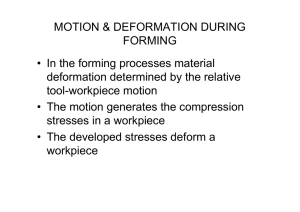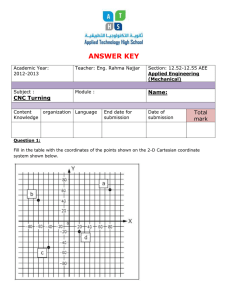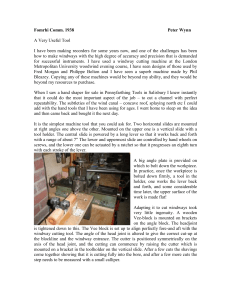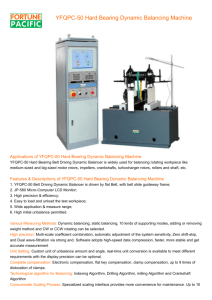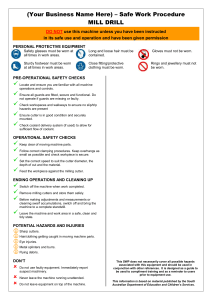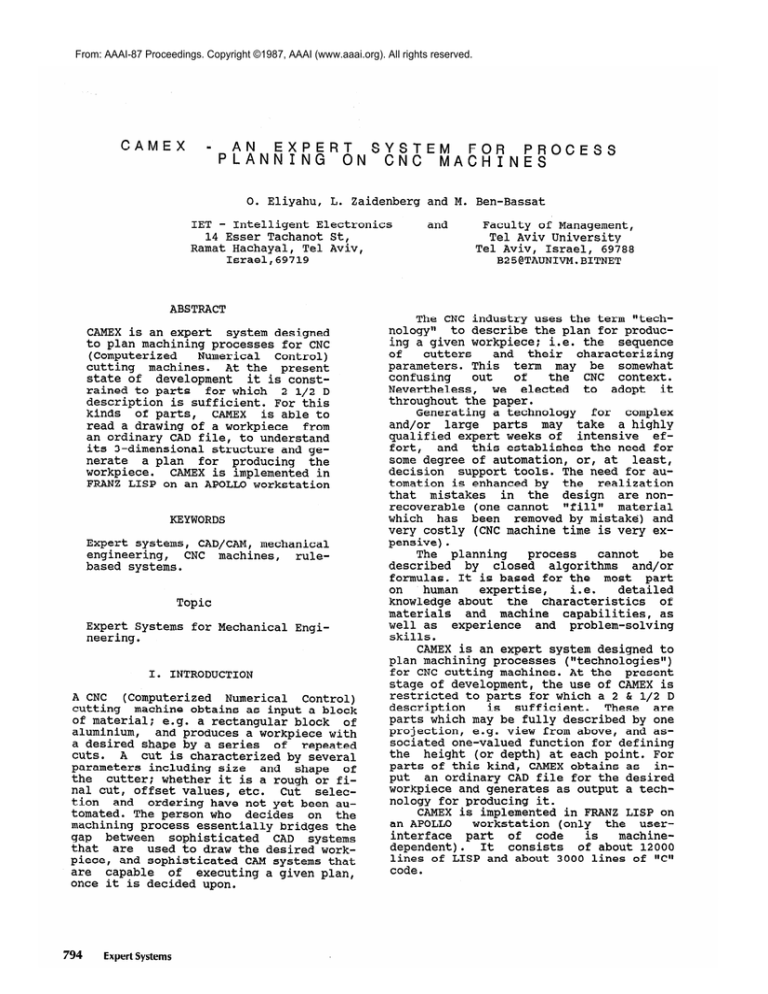
From: AAAI-87 Proceedings. Copyright ©1987, AAAI (www.aaai.org). All rights reserved.
CAMEX
-
AN
EXPERT
PLANNING
0. Eliyahu,
ON
L. Zaidenberg
IET - Intelligent
Electronics
14 Esser Tachanot St,
Ramat Hachayal,
Tel Aviv,
Israel,69719
ABSTRACT
CAMEX is an expert
system designed
to plan machining
processes
for CNC
(Computerized
Numerical
Control)
cutting
machines.
At the
present
state of
development
it is constrained to parts
for which
2 l/2 D
description
is sufficient.
For this
kinds
of parts,
CAMEX is able to
read a drawing of a workpiece
from
an ordinary
CAD file,
to understand
its 3-dimensional
structure
and generate
a plan
for
producing
the
workpiece.
CAMEX is implemented
in
FRANZ LISP on an APOLLO workstation
KEYWORDS
Expert systems,
CAD/CAM, mechanical
engineering,
CNC machines,
rulebased systems.
Topic
Expert Systems
neering.
I.
for
Mechanical
Engi-
INTRODUCTION
A CNC (Computerized
Numerical
Control)
cutting
machine obtains
as input a block
of material;
e.g. a rectangular
block
of
aluminium,
and produces a workpiece
with
a desired
shape by a series
of
repeated
cuts.
A cut is characterized
by several
parameters
including
size
and shape
of
the
cutter;
whether it is a rough or final cut, offset
values,
etc.
Cut selection
and ordering
have not yet been automated.
The person who decides
on the
machining
process essentially
bridges
the
gap between
sophisticated
CAD systems
that
are
used to draw the desired
workpiece,
and sophisticated
CAM systems that
are
capable
of
executing
a given plan,
once it is decided upon.
794
Expert Systems
SYSTEM
CNC
FOR
MACHINES
PROCESS
and M. Ben-Bassat
and
Faculty
of Management,
Tel Aviv University
Tel Aviv,
Israel,
69788
B25eTAUNIVM.BITNET
The CNC industry
uses the term "techto describe
the plan for producnologyll
ing a given workpiece;
i.e.
the
sequence
of
cutters
and their
characterizing
parameters.
This
term
may be somewhat
confusing
the
CNC context.
out
of
Nevertheless,
we elected
to
adopt
it
throughout
the paper.
Generating
a technology
for
complex
and/or
large
parts
may take
a highly
qualified
expert weeks of
intensive
effort,
and this establishes
the need for
some degree of automation,
or, at
least,
decision
support
tools.
The need for automation
is enhanced by the
realization
that
mistakes
in the
design
are nonrecoverable
(one cannot
llfill"
material
which
has been removed by mistake)
and
very costly
(CNC machine time is very expensive).
The planning
process
cannot
be
described
by closed
algorithms
and/or
formulas.
It is based for the
most part
on
human
expertise,
i.e.
detailed
knowledge about
the
characteristics
of
materials
and machine
capabilities,
as
well as experience
and problem-solving
skills.
CAMEX is an expert
system designed to
plan machining
processes
("technologiesll)
for CNC cutting
machines.
At the
present
stage of development,
the use of CAMEX is
restricted
to parts for which a 2 & l/2 D
description
is
sufficient.
These
are
parts which may be fully
described
by one
projection,
e.g. view from above, and associated
one-valued
function
for defining
the
height
(or depth) at each point.
For
parts of this kind,
CAMEX obtains
as inan ordinary
CAD file
for the desired
put
workpiece
and generates
as output a technology for producing
it.
CAMEX is implemented
in FRANZ LISP on
an APOLLO
workstation
(only
the
userinterface
part
of
code
is
machinedependent).
It
consists
of about 12000
lines
of LISP and about 3000 lines
of llC'l
code.
II.
GENERAL APPROACH
Three main components are required
system such as CAMEX:
for
a
1.
Problem representation,
that
is
the
system's
ability
to
perceive
(to
rlseell) a workpiece
in
the
various
stages
of
its
production
and to
recognize
the
legitimate
tools
and
their
capabilities.
2.
Knowledge
base,
that
is
machine
representation
of the knowledge used
a CNC
by human experts
in designing
technology.
3.
Inference
and control
mechanism, that
is
algorithms
that
- upon "understanding"
a given workpiece
- access
relevant
parts of the knowledge base
and construct
a technology
for
producing it.
III.
PROBLEM REPRESENTATION
The starting
point of a human expert is a
technical
drawing on paper or on computer
screen displays.
Looking at the drawings,
he creates
in his mind a 3-D model of the
desired workpiece
and then
proceeds
to
generate the technology.
The first
step in
CAMEX development
was to provide
it with a 3-D model of the
desired workpiece.
We started
by developing
a
language
for
describing
the
geometrical
properties
of the
workpiece.
The idea behind the language was the notion of a human CNC expert who has become
blind
and now requires
an assistant
to
describe
the desired workpiece
to him.
In this language,
the
workpiece
is
described
as a list
of geometrical
primitives with their
attributes
and the relations
between
them. Two types of primitives
exist
in the
language
: subparts
and surfaces.
Subparts
classified
are
cavities
and material.
into 2 types:
For
is a primitive
of type
example,
profile
and by external
profile
we mean
cavity,
the
material
that
must be removed
all
from the initial
block in order to
reach
the
external
wall of the workpiece.
Most
of the primitives
were chosen
by virtue
of their
representing
basic technological
structures
(pocket,
profile,
hole,
bay
The attributes
of a primitive
are
etc.).
described
in terms of Dmax (diameter
of
largest
possible
cutter),
Dmin (smallest
corner
diameter),
relations
etc.
The
between
primitives
are described
in such
terms as is-above,
is-below,
is-aside,
is-limited-by,
etc.
Figure 1 provides
a description
of
a
workpiece
using
the language.
A similar
approach
to
the
workpiece-geometry
description
was used by Descotte
and Latombe [Descotte
and Latombe,l981].
It was soon realised,
however,
that
describing
real-world
workpieces
in such
a language is a very
time-consuming
and
error-prone
activity.
Worse still
was the
fact that CAMEX could in
no way verify
the
user-supplied
description.
On the
other hand, it was discovered
that a substantial
amount of the relevant
geometrical information
could be extracted
from
CAD files
of the technical
drawings.
We
proceeded
therefore
to
developing
a
preprocessor
that would generate a workpiece representation
directly
from
the
CAD files.
Today,
CAD systems
describe
part
geometry
as a collection
of low-level
geometrical
primitives:
line
segments,
polylines
(strings),
circles
and arcs,
and splines
(see Figure 2). This
collection,
when presented
graphically
to the
human eye, allows the human brain to imagine
the 3-dimemensional
geometry of the
part.
In
addition
to
"real"
geometrical
primitives
such as points
and line segments which are actually
seen when viewing
the
workpiece,
a CAD file
also contains a large amount of auxiliary
information,
such as dimension
lines and textual material.
Such information
must be
identified
and removed from the CAD file
if we are going to attempt automatic
interpretation.
Other
problems
in
realworld CAD files
are
limited
precision
(can we assume 85.4 and 85.5 to be the
same number ?), overlapping
lines,
etc.
The CAMEX preprocessor
l'cleans'l
the
CAD file
of non-relevant
elements,
scans
it and produces as output
a geometrical
database
that describes
the workpiece
in
terms of higher-level
primitives
- such
as pockets,
holes,
profiles,
etc. These
primitives
are displayed
to the user, who
is requested
to supply the height
(depth)
of each primitive.
The resulting
workpiece
description
is
implicitly
equivalent
to
the
language
description
mentioned
above.
The preprocessor
goes
beyond the
mere identification
of
the
basic
geometrical
entities.
It
also
searches the data
base for
thin
walls
boundaries,
i.e.
walls with a width less
than some prespecified
threshold.
Thin
walls
play
an important
part in technological
decisions,
and it is
more efficient
to
collect
information
about them
in the preprocessing
stage.
A one-to-one
link
is
maintained
between
the
original
CAD primitives
and
the higher-level
geometrical
primitives.
Thus the user may point to any region in
the drawing and make queries
in the form:
Eliyahu, Zaidenberg, and Ben-Bassat
795
is a specified
a hole ?,
a pocket ?
what are the
region ?
region
neighbors
a wall
?,
of a specified
be
(Such queries may also
check the claim that CAMEX really
stands"
the workpiece.)
used to
"under-
**********************************t
profile-b
************************************
is-a:
profile
is-above:
()
is-below:
()
(wall-b7
wall-b8)
is-aside-of:
is-limited-from-above-by:
()
is-limited-from-below-by:
()
is-limited-from-side-by:
()
y-;-Q;
0
: 20
z-low:
0
d-max: 50
d-min: 20
r-fillet:
nil
depth: 20
width:
60
clearance:
nil
tolerance:
nil
area: 10000
Figure
of a workpiece
1: A description
using CAMEX language.
IV.
REPRESENTATION OF KNOWLEDGE.
Geometrical
knowledge
is
embedded
in
CAMEX problem representation.
Additionally,
knowledge
about
the
use of
CNC
machines for a variety
of workpieces
made
of various
types of material
is
provided
in the form of rules.
Here are a few examples of the rules:
IF total-volume
of nc-jobs
for
tool
is less than 50000
AND nc-jobs
for tool are pockets
only
AND tool is larger
than 16
AND smaller
tool is with rad 0
THEN change tool to smaller
tool.
IF nc-entity
is pocket or profile
AND wall-thickness
is less than
THEN set wall-offset
to 0.05
AND DEFINE wall-finish
2.0
The rule base is
treated
not
as a
static
collection
of knowledge chunks,
but as a kind of very high-level
programming
language
for
describing
the
technology-generation
process.
This
is
achieved
by rules that guide the control
strategy
and assist
in breaking
down the
problem into subproblems
and in determining the order in which
the
subproblems
are to be solved.
For instance,
the rule
IF tool was changed
THEN PERFORM select
nc-entity
tools
guides the system to use a set
of rules
relevant
for tool selection
for a single
nc-entity.
Such an organization
has the
advantage of efficiency,
because at every step
of technology
generation
only
a small
of rules
is eligible
for checking.
group
Thus the cycle time of each rule application
is
independent
of the total
number
of rules in the rule
base.
The primary
disadvantage
is inconvenience
in the debase,
bugging of the
knowledge
because
the
meaning
of some rules may depend on
the organization
of the rule base.
The rules are formulated
by the
experts in structured
English.
CAMEX has a
rule translator
module that automatically
translates
rules into LISP and adds them
to the knowledge
base
3).
(see Figure
This
provides
the
experts with a great
deal of independence
in maintaining
the
knowledge base and in checking the impact
of rule modifications.
Figure
2: A typical
V. INFERENCE MECHANISMS
CAD file.
CAMEX works
Step
796
Expert Systems
in
four
1. Removal
main steps:
identification:
CAMEX
starts
by identifying
a set of
fillers
(cylinders
with arbitrary
cross-sections),
which, upon removal from the initial
block
of
material,
produce the workpiece.
There
are
generally
many such
sets (one is obtained
by defining
a filler
for each region with
zcoordinate
less
than the height
of the initial
block),
but
technological
considerations
make
some sets
illegal,
and
some
preferable.
The rules for choosing fillers
are
constraints
on
legal
removals.
For example, in
Figure 4,
alternative
(a)
consists
of the two cylinders
above
the regions A and C with z-extent
from
3mm to
16mm, and the
cylinder
above the region B with
z-extent
from
12mm to 16mm. Alternative
(b)
consists
of
the
cylinder
above regions A, B and C
with z-extent
from 12mm to
16mm,
and the
two cylinders
above regions A and C with z-extent
from
3mm to 12mm.
The process
is
basically
a
depth-first
search,
and in most
practical
cases the search
space
is
quite
small (perhaps tens of
possibilities).
To handle
the
rare cases where the search space
is large,
rules of thumb are used
to limit
the space. At the end of
this search
we have a set
of
fillers
each of which corresponds
to a removal
(pocket,
profile,
top-of-wall
etc.).
The resulting
list
of
removals approximately
corresponds
to
the list
of nc-primitives
which,
in
the
early
version
of CAMEX,
were explicitly
entered
by the
user
(see the section
on Problem
Representation
and Figure
1).
Size parameters
(such as Dmin for
pockets and profiles)
and spatial
relations
between
removals
(aside-of,
above,
etc.),
which
previously
were explicitly
specified by the user, are now determined easily
from the geometrical
database on an as-needed basis.
for indiviStep 2. Technology generation
dual removal.
Rules such as:
in a forward-chaining
produce
a list
Step 3. Cutter optimization:
The purpose
of this step is to achieve better
utilization
of the
cutters
by
taking
a global view of the workpiece.
The relevant
of
rules
have the
form:
IF cutter
is used only once
THEN remove it from
part-tools-list
AND retry
select-part-tools.
Different
criteria
may
be
used
for
cutter
optimization.
For example, time
of processing
of
each workpiece
may be crucial
for large production
lines;
however,
for
prototyping,
time of
generating
a feasible
technology
(not
necessarily
an efficient
one) may be more important.
Step 4. Sorting
of operations:
Basically,
the
relevant
rules for this step
are constraints
on the legal order of
operations.
Two kinds of
constraints
exist:
o'must
beWq
rules
and 81should bet1 rules.
For
instance:
wall-top
MUST BE before
profile
or pocket with the same wall
nc-jobs
for the same tools
BE sequenced by decreasing
SHOULD
volume
Both kinds of rules
imply
a
partial
order of the operations.
It is usually
not
really
important which operation
comes first,
as long as all
constraints
are
satisfied.
VI.
IMPLEMENTATION
The main system
IF nc-entity
is pocket
AND fillet
rad is smaller
than 5.0
AND floor
thickness
is greater
than 3-O
THEN set floor
offset
to 0.0
AND set wall offset
to fillet
rad
are applied
manner
to
operations
for each removal.
Each
removal
(nc-entity)
defines
one
or more operations
(cuts,
ncjobs).
Each operation
is defined
by the relevant
removal,
the
diameter
and corner radius of the
cutter,
and other parameters.
modules
are:
Reads
Geometry Understanding
Module.
the
CAD system output file
and builds
a
data structure
describing
the
workpiece
Because of the t'noise@l includgeometry.
ed in real world drawings
(even computeramount of interacones), a certain
ized
needed at this
tion with the
user
is
stage.
This
module
Rule Translator
Module.
accepts rules from the user in structured
Eliyahu, Zaidenberg, and Ben-Bassat
797
English
and translates
them into internal
This module may be considered
LISP form.
language
as a compiler
from a high-level
into
describing
technology
generation,
LISP.
Control
and Inference
Module.
This
module
controls
the overall
operation
of
implemented
CAMEX; calls
procedurally
steps;
and triggers
and fires
rules from
the rule-base.
This
module
Module.
Explanation
the
process of rule application:
traces
(LISP)
translates
rules
from
internal
and generates
explanaform
to
English
tions
regarding
the system reasoning
process.
It
allows
the user to ask guest-ions such as why a particular
operation
in what context,
a
was added,
why,
or
etc.
This
particular
rule
was used,
module
may
be considered
as a kind of a
symbolic
domain-oriented
debugger.
7 we show the end result
of
In Figure
a technology
for
the entire
CAMEX, i.e.
workpiece.
VII.
ACNOWLEDGEMENT
This
supported
by
the
project
was
Engineering
Division
of Israel
Aircraft
Inc. and performed
in collaIndustries,
The authors
boration
with
their
staff.
are specifically
grateful
to Mr. R. Razi
for many useful
discussions.
REFERENCES:
[Descotte
and Latombe,l981]
Y. Descotte
&
Latombe. "GARI : A problem solver
J.
that plans how to machine
mechanical
Vancouver,
parts".
In Proc. IJCAI-81,
1981.uh.
766-772.
Figure
798
3: Automatic
Expert Systems
rule
translation
of removals
same end product.
Figure
4: The possible
-that
yield
the
sets
Figure
5: A technology
workpiece.
for
the
entire

